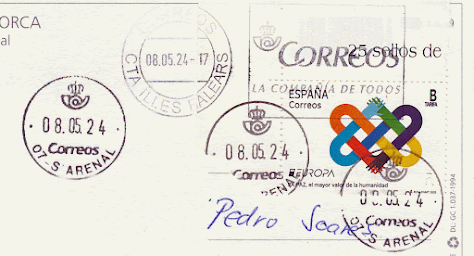COVER N. 477 - LITHUANIA
Postmark: Kaunas Lietuva 14.06.2024
Posted on the 14th June; received on the 20th June 2024
_________________________________________________________________________________
A cover coming from the Baltic... It is high time I put the Baltic States on my travelling agenda again. They were scheduled, in the company of Belarus for the 2020 holidays, but then the bloody virus made its appearance and I had to postpone. Nowadays, another type of virus does not make a journey to Belarus an enjoyable prospect, so I'll have to limit myself to the three states bordering the Baltic... not for this year though since things are already settled for the holidays.
Meanwhile I'll be more than happy to keep receiving mail from that neck of the woods, such as the nice cover I got from Jonas. Labai ačiū, Jonas!
Stamps, left to right, top to bottom:
- Lithuanian Rulers, is the theme of a three auto-adhesive stamp definitive set, (0.05; 0,20; 1.20 €) issued on 24FEB2024.
The 0.20 € stamp on the cover bears the effigy of Grand Duke Kęstutis (1300-1382) who ruled Lithuania from 1381 till being killed in the very next year as a result of dynastic intrigues that corroded the regular succession to the throne of the Grand Duchy of Lithuania.
- The State Flag of Lithuania illustrates the 0,03€ stamp, part of a 3 stamp definitive a issued on 04JAN2019 dedicated to Historic National Flags.
- Part of the same set is the 0,49€ stamp illustrated with the State flag of Lithuania. The yellow stripe is symbolic of the wheat and freedom from want; the green signifies hope and the nation's forests, and the red the love for the country and the blood of those that gave their lives fighting for the country.
- Lithuania declared its independence from the Soviet Union in 1990, after the period of German and Soviet occupation, initiated during the period of the second world war.
Although clearly marked with a 1990 legend, the stamp with the image of the Lithuanian Liberty bell is part of the second definitive issue of present day Lithuania, which began to circulate on 10JAN1991, comprising five stamps, three (10;20;30 Russian Kopeks) illustrated with the national symbol of the State, a Vytis, a mounted armoured knight holding a sword and shield; one (50 Kopeks) with the image of the Hill of Crosses in Siauliai and the 200 Kopek stamp on the cover, illustrated with aforementioned Liberty Bell.
The Lithuanian Liberty bell was funded by American Lithuanians in 1919, in the image of American Liberty Belli as a way to promote Lithuania as a free independent state.
On one side the following is inscribed:
Oh, ring through the ages,
for the children of Lithuania;
For one is not worthy of Liberty,
Who does not defend her!
the other side bears the following inscription:
“The American Lithuanian Convention to Lithuania, June 9, 10 and 11, 1919, Chicago, Illinois. Let this Bell, be a symbol of liberty, a testimonial for future generations of the solicitude and love that American Lithuanians bore for their fatherland Lithuania.”
The Lithguanianm Liberty Bell is now kept at the Vytautas the Great War Museum, in Kaunas, the place of origin of the cover.
- The 5 cent stamp in the middle of the second row is part of a three stamp set (5; 80 cents; 1 Litas), issued on 25JUL1994, dedicated to the traditional costumes of the Samogitians, the inhabitants of Samogitzia, one of the five ethnographic regions of the country: Samogitia; Lithuania Minor; Aukštaitija; Suvalkija and Dzūkija.
- Finally the 0,95€ stamp is part of the 2023 Europa issue dedicated to the theme "Stories and Myths" and it evokes the legend of Eglė the Serpent Queen. .
the issue, which started to circulate on 29APR2022, was competed by another stamp, with the same face value, dedicated to the "Legend of the Blooming Fern".
Of note is the fact that as above stated, the cover contains stamps in the three currencies that at one time or other were or are in use in Lithuania since it regained its independence.
The Postmark hails from Kaunas, the second largest city of Lithuania, with a population of about 304,200 inhabitants, a UNESCO World Heritage Site, known for its Art Deco architecture.































